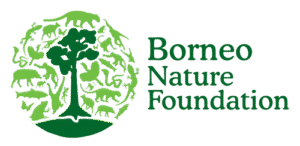Written by Desi Natalia (BNF Communications Officer)
Recently, Dr Mark Harrison (BNF Co-director) came across an old map of Central Kalimantan (Indonesian Borneo) printed on silk from the 1940s. There are many village names on the map that remain the same today, but some of the villages are spelt differently. For instance, ‘Poeroektjaoe’ is now written ‘Puruk Cahu’. The map also shows that the majority of the villages are located along the river and not in peatland areas. Palangka Raya, today’s capital of Central Kalimantan province, does not appear on this map from 77 years ago.
Central Kalimantan was originally an area of the Sultanate of Banjarmasin. In 1787, Sultan Tahmidullah II of Banjarmasin gave up some territory to the VOC (Dutch: Vereenigde Oost-Indische Compagnie; The United East Indian Company), including a Dayak area (known today as Central Kalimantan). After the VOC went bankrupt and was dissolved, the territory was taken over by the Dutch through the Governor General of the Dutch East Indies in Batavia (Jakarta). Starting in 1938, the Dutch government established a government in Kalimantan, called ‘Bovernement Van Borneo’ and Banjarmasin as the capital. Central Kalimantan region was named ‘Dajaksche provintien’. However, it is important to know that at this time the Dayak community named Borneo “Lewu gadung batu” according to the book Panaturan (The Holy Book of Kaharingan – Dayak’s tribe).

After the independence of Indonesia in 1945, the Government of the Republik Indonesia Serikat (RIS) issued regulations to divide the RIS area into 10 provinces and 2 provincial administratives. One of them is Kalimantan, which included three residences: the residency South Kalimantan, East Kalimantan residency, and residency of West Kalimantan.
Swapraja Kotawaringin, consisting of Kapuas, Barito, and Kotawaringin, belonged to the residency of South Kalimantan. In 1952, the people of the Swapraja Kotawaringin demanded the formation of the Central Kalimantan province. Finally, central government approved the establishment of the Central Kalimantan province on 23 May 1957 and announced the village of Pahandut as the capital ‘Palangka Raya’ based on a proposal from Dayak leaders.
The name was taken from folklore, of a Dayak community in Central Kalimantan, about the origins of human ancestors. Palangka Bulau is the name of King Bunu’s vehicle, he once instructed Ranying Hatalla Langit (God Almighty) to come down to Earth. Palangka Bulau is a great vehicle that is equipped with a variety of supplies and all the necessities of life, such as equipment for farming and hunting, and weapons. While Bulau in Dayak Ngaju language means ‘gold and silver’ in the context of Dayak belief it is used to describe paradise. The existence of heaven is holy and so beautiful is termed as Bulau, so it was replaced with the word ‘Raya’, which in Indonesian means grand or big. So, Palangka Raya means a very big, beautiful and holy place.
Based on this history, we know that the name of Palangka Raya was formed after the independence of Indonesia and the early development of this city started from the Pahandut village on the Kahayan River. The existence of this village is already visible on this map from the 1940s, as well as many other old villages, which still exist today, but with a slightly different spellings. They used different spellings in the 1940s because the language used is not Indonesian, but written to follow the Dutch spelling of the time. As Poeroektjaoe which is now turned into Puruk Cahu, writing ‘oe’ read ‘u’ and ‘tj’ read ‘c’.
If you look at the location of the old villages in Central Kalimantan, there are not many villages in the south where it is predominantly peatland. Just a few villages are located in this peat area, which would have been on a thin layer of peat close to the river. The majority of Dayak people have never lived on or close to a thick layer of peat. The stories from Dayaks suggest that they never wanted to cultivate peatland because they know that peat can not be managed. So, the Dayak people never opened peatlands, but farmed on ordinary mineral soil. When they cleared land they used a firebreak system, so there is no spread of fire or excessive smoke.
This map is a great find and a snaptshot of Central Kalimantan’s history. It tells us of where Borneo has come from and, as we continue our work, we will have front row seats to see how it may change in the future. But it is not all about looking forward. Sometimes it is important to look back and learn from our ancestors. As we know from these stories, Dayaks may have been the first ‘peatland conservationists’.
Source :
Central Kalimantan History
Central Kalimantan & Palangka Raya History













